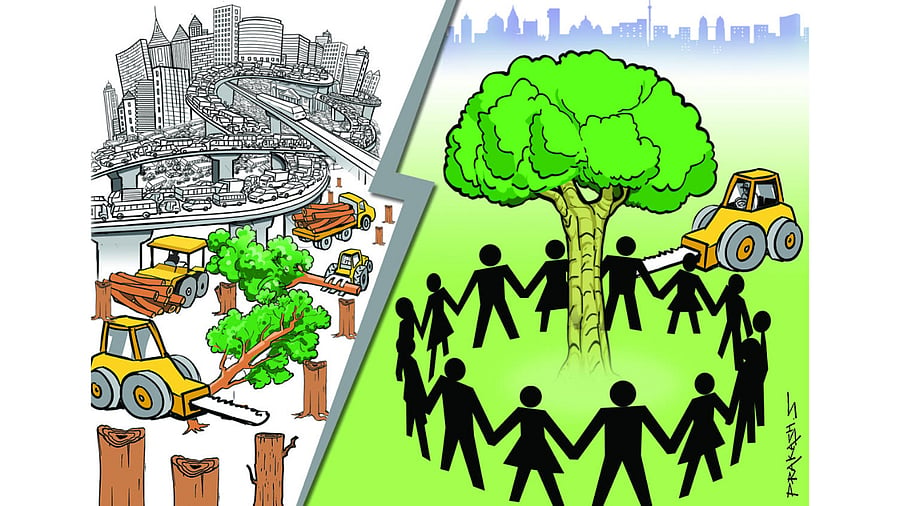
Informed public activism. Now that sounds like a robust defence against the might of a system bulldozing through the city’s green expanse to build road projects imposed with a top-down flourish.
To back up that activism and make it truly transformative in protecting the city’s shrinking tree cover, a set of legally mandated guidelines are now in force. A campaign is now on to educate the citizenry, so that their protests are based on rules designed to stop that axe from indiscriminate tree-felling.
Two months ago, as the city slept, dozens of fully grown trees of ‘heritage’ vintage were axed on Old Airport Road to make way for a signal-free corridor. Local residents were shocked to see those green behemoths gone in a jiffy. Most were left wondering whether they could have prevented it if they were better informed of what the rules said.
Awareness gap
Recalls Swathi Damodaran, a Vinayakanagar resident who later filed her objections, recalls: “When I first saw the destruction, I was totally unaware like 90% of the citizens. Only when I got on the ground did I realise there is a Tree Act, a tree committee and the tree-felling details need to be put on the BBMP website.”
Clearly, most citizens are unaware of their rights. Through a Public Interest Litigation (PIL) filed in April 2018, the Bangalore Environment Trust (BET) had managed to get the High Court spell out the rules and ensure strict implementation of the Karnataka Preservation of Trees Act 1976.
So, the problem was this: The Tree Act was a ready template that mandated public consultation, inspection of every tree identified for axing and a systematic process. But the Act’s provisions were rarely implemented, and citizens had no clue.
Tree Census
One glaring dilution in the Act’s implementation was the tree census. The High Court had observed the census was not carried out for nearly 43 years since the provisions of the Tree Act came into force. In February 2020, the Court even considered contempt proceedings against the authorities.
However, the legal directive had the authorities finally cracking. Till December 2020, about 46,000 trees have been enumerated. Census details are now uploaded on the website of the Bruhath Bengaluru Mahanagara Palike (BBMP). And, a mobile App is now under development with features such as geo-tagging, notes BET.
Tree Committee
Another dilution was in the functioning of the Tree Expert Committee (TEC). A BET office-bearer cites a Court observation that the TEC’s previous members had taken a very casual approach to their job. There was no application of mind to ensure the survival of a tree identified for transplantation.
Thanks to this legal intervention, the reconstituted TEC now has more experts. In recent episodes, it has devised and followed a more rigorous process to save the trees.
Transplantation
Transplantation / translocation of a tree is often shown as a solution by project planners. But the Court had noted that the survival of such trees is not guaranteed without adequate care. The Tree Officer is now tasked with ensuring the survival. The University of Agricultural Sciences (UAS) has now evolved a detailed scientific procedure for all transplantation.
Exempted trees
Seeking to fell 872 trees for the Namma Metro project, the Bangalore Metro Rail Corporation Limited (BMRCL) had taken recourse to Section 8(7) of the Tree Act. The Section, it argued, allows a person/entity to axe certain kinds of trees without permission.
This was contested by BET in the Court. It cited established environmental jurisprudence to argue that BMRCL’s interpretation was inaccurate. “The Court held that the precautionary principle along with the principles of public trust and sustainable development are applicable to public authorities such as BMRCL, and an attempt must be made to save as many trees as possible.”
Eventually, BMRCL had to refer the 872 trees to the TEC, which found that 32 trees were not even exempted species under the Trees Act. “BMRCL has thereafter undertaken to refer all applications to the TEC, irrespective of whether these are ‘exempted’ or not.”
Citizen participation
Now that a procedure is in place, it is time that citizens properly study them and submit meaningful objections to trees identified for felling. This will help the tree committee take congnisance, notes a petitioner. “The ball is in the citizens’ court. They have to participate wholeheartedly,” he says.
Urban conservator Vijay Nishanth echoes this view when he notes, “There was no transparency and accountability on projects and trees before. People should now take advantage of the provisions and be constructive. Protesting alone will not help. The public should ask the right questions.”
Check out DH's latest videos: